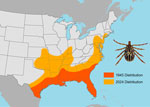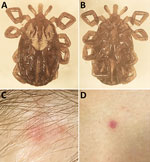Disclaimer: Early release articles are not considered as final versions. Any changes will be reflected in the online version in the month the article is officially released.
Volume 30, Number 10—October 2024
Research Letter
Migration of Amblyomma maculatum Ticks and Rickettsia parkeri into the Northeastern United States
Suggested citation for this article
Abstract
We document a case of Rickettsia parkeri rickettsiosis in a patient in Connecticut, USA, who became ill after a bite from a Gulf Coast tick (Amblyomma maculatum). We used PCR to amplify R. parkeri DNA from the detached tick. The patient showed a 4-fold rise in IgG reactive with R. parkeri antigens.
Native and invasive tick species pose serious public health concerns in the United States, particularly in northeastern states. Recent and rapid expansion of the lone star tick (Amblyomma americanum) into ranges with pervasive blacklegged tick (Ixodes scapularis) populations has increased the number of recognized tickborne pathogens that circulate in that densely populated region. In addition to Borrelia burgdorferi, the causative agent of Lyme disease, >6 additional tickborne pathogens are now endemic to the northeastern United States: Ehrlichia chaffeensis, Ehrlichia ewingii, Heartland virus, Anaplasma phagocytophilum, Babesia microti, and Powassan virus (1). Multiple factors, including climate change and anthropogenic modifications to the environment, have affected rapid expansion of the ranges of medically relevant tick species and associated pathogens. That expansion has been reflected by dramatic increases in the numbers of reported cases of tickborne diseases in the northeastern United States since the beginning of the 21st Century (1,2).
The Gulf Coast tick (Amblyomma maculatum) was first described in the United States in 1844. As recently as the middle of the 20th Century, the tick’s range was restricted predominantly to coastal regions of states bordering the Gulf of Mexico as far west as Texas and the southern Atlantic coast only as far north as southern North Carolina (Figure 1) (3). Established A. maculatum tick populations now exist in states hundreds of miles inland (Arkansas, Missouri, Kentucky, Illinois, Indiana) and along the Atlantic coast as far north as Connecticut (4–9). Migratory grassland birds serve a crucial role in the spread of Gulf Coast ticks to locations in central and northern states that possess favorable environmental conditions for the tick’s survival (2,8).
The Gulf Coast tick was relatively unknown and poorly studied until recognition of Rickettsia parkeri spotted fever rickettsiosis in 2004 (2). In contrast to its more widely recognized cousins, blacklegged and lone star ticks, which prefer predominantly woodland habitats, Gulf Coast ticks favor grassland habitats. During the past 250 years, huge swathes of native grasslands and savannahs in the eastern United States have been transformed into agricultural areas and rangeland, creating habitats no longer favorable for Gulf Coast ticks. Paradoxically, contemporary reclamation of native grasslands through conservation efforts in the northeastern United States might have inadvertently led to establishment of Gulf Coast ticks in that region. The recent discovery of established populations of Gulf Coast ticks in reclaimed grasslands at the former Freshkills landfill on Staten Island, New York, is a salient example of this phenomenon (7,8). Of note, restored grassland habitats often occur near or within shorelines, parks, and wildlife areas proximate to and frequented by persons residing in densely populated metropolitan areas.
The Gulf Coast tick is the principal vector of R. parkeri, a pathogen that causes a spotted fever rickettsiosis similar to but milder than Rocky Mountain spotted fever (2). Rates of R. parkeri infection are as high as 56% among questing adult Gulf Coast ticks in some regions, and 23%–53% of adult specimens obtained in Connecticut, New York, and New Jersey are infected (6–9). Gulf Coast ticks readily bite humans, posing another risk for tickborne disease in northeastern United States, particularly among persons who reside and recreate near or within New York, New York; New Haven, Connecticut; Newark, New Jersey; and Philadelphia, Pennsylvania, where recently established tick populations have been identified in areas where human infections with this pathogen had not been previously documented (Figure 1).
In August 2023, a 29-year-old woman discovered a tick attached to the nape of her neck after visiting a beach in Fairfield County, Connecticut. The tick (Figure 2, panels A, B) was attached for ≤4 hours before it was removed. Within 3 days, a small, erythematous, crusted lesion with a smaller satellite papule developed at the bite site (Figure 2, panel C), after which the patient experienced chills, fatigue, cervical lymphadenopathy, myalgia, severe headache, and mild confusion. Approximately 10 days later, several small erythematous macules developed on her arm and legs (Figure 2, panel D). The patient recovered rapidly after treatment with doxycycline. We performed PCR to amplify R. parkeri DNA from the detached tick; indirect immunofluorescence antibody assay results of patient serum samples revealed IgG reactive with antigens of R. parkeri at titers of <32 at 15 days and 256 at 24 days after illness onset (Appendix).
Because of morphologic similarities between Gulf Coast ticks and American dog ticks (Dermacentor variabilis, the principal vector of Rocky Mountain spotted fever in the northeastern United States), the 2 species can be misidentified. Because most tick species are associated with a unique suite of pathogens, it is critical to improve regional capacity for accurately detecting and identifying specific ticks and the pathogens they transmit in the northeastern United States, an area already endemic for Lyme disease, Rocky Mountain spotted fever, ehrlichiosis, anaplasmosis, and Powassan virus infections (10). The rapidly changing dynamics and evolving risks of tickborne diseases across this region reinforce the need for awareness of and education on tick bite prevention strategies, including using repellents registered with the Environmental Protection Agency and performing regular, thorough tick checks after exposure to tick-infested areas.
Dr. Molaei is a research scientist and director of the Tick and Tick-borne Pathogen Surveillance Program at the Center for Vector Biology and Zoonotic Diseases and the Northeast Regional Center for Excellence in Vector-Borne Diseases of the Connecticut Agricultural Experiment Station, and also an associate clinical professor at the Yale School of Public Health. His current research interests include the ecology and epidemiology of tickborne and mosquitoborne pathogens of human health concern.
Acknowledgment
The authors thank Jay Kiser for assistance in creating Figure 1, and Lorelei Sandland for assistance with creating Figure 2.
References
- Molaei G, Eisen LM, Price KJ, Eisen RJ. Range expansion of native and invasive ticks: a looming public health threat. J Infect Dis. 2022;226:370–3. DOIPubMedGoogle Scholar
- Paddock CD, Goddard J. The evolving medical and veterinary importance of the Gulf Coast tick (Acari: Ixodidae). J Med Entomol. 2015;52:230–52. DOIPubMedGoogle Scholar
- Bishopp FC, Trembley HL. Distribution and hosts of certain North American ticks. J Parasitol. 1945;31:1–54. DOIGoogle Scholar
- Phillips VC, Zieman EA, Kim CH, Stone CM, Tuten HC, Jiménez FA. Documentation of the expansion of the Gulf Coast tick (Amblyomma maculatum) and Rickettsia parkeri: first report in Illinois. J Parasitol. 2020;106:9–13. DOIPubMedGoogle Scholar
- Maestas LP, Reeser SR, McGay PJ, Buoni MH. Surveillance for Amblyomma maculatum (Acari: Ixodidae) and Rickettsia parkeri (Rickettsiales: Rickettsiaceae) in the state of Delaware, and their public health implications. J Med Entomol. 2020;57:979–83. DOIPubMedGoogle Scholar
- Molaei G, Little EAH, Khalil N, Ayres BN, Nicholson WL, Paddock CD. Established population of the Gulf Coast tick, Amblyomma maculatum (Acari: Ixodidae), infected with Rickettsia parkeri (Rickettsiales: Rickettsiaceae), in Connecticut. J Med Entomol. 2021;58:1459–62. DOIPubMedGoogle Scholar
- Bajwa WI, Tsynman L, Egizi AM, Tokarz R, Maestas LP, Fonseca DM. The Gulf Coast tick, Amblyomma maculatum (Ixodida: Ixodidae), and spotted fever group Rickettsia in the highly urbanized northeastern United States. J Med Entomol. 2022;59:1434–42. DOIPubMedGoogle Scholar
- Ramírez-Garofalo JR, Curley SR, Field CE, Hart CE, Thangamani S. Established populations of Rickettsia parkeri-infected Amblyomma maculatum ticks in New York City, New York, USA. Vector Borne Zoonotic Dis. 2022;22:184–7. DOIPubMedGoogle Scholar
- Musnoff BL, Cuadera MKQ, Birney MR, Zipper L, Nicholson W, Ayres B, et al. The first record of an established population of Amblyomma maculatum (Acari: Ixodidae) in New Jersey, USA. J Med Entomol. 2024;61:1081–5. DOIPubMedGoogle Scholar
- Eisen RJ, Paddock CD. Tick and tickborne pathogen surveillance as a public health tool in the United States. J Med Entomol. 2021;58:1490–502. DOIPubMedGoogle Scholar
Figures
Suggested citation for this article: Molaei G, Khalil N, Ramos CJ, Paddock CD. Migration of Amblyomma maculatum ticks and Rickettsia parkeri into the northeastern United States. Emerg Infect Dis. 2024 Oct [date cited]. https://doi.org/10.3201/eid3010.240821
Original Publication Date: September 18, 2024
Table of Contents – Volume 30, Number 10—October 2024
| EID Search Options |
|---|
|
|
|
|
|
|


Please use the form below to submit correspondence to the authors or contact them at the following address:
Goudarz Molaei, Department of Entomology, Connecticut Agricultural Experiment Station, 123 Huntington Street, New Haven, CT 06511, USA
Top